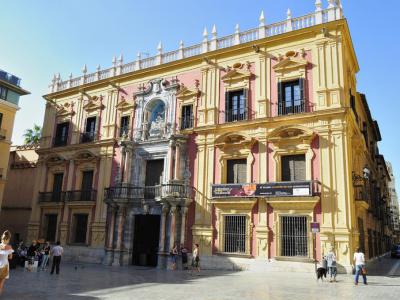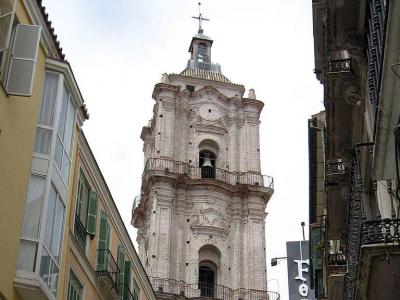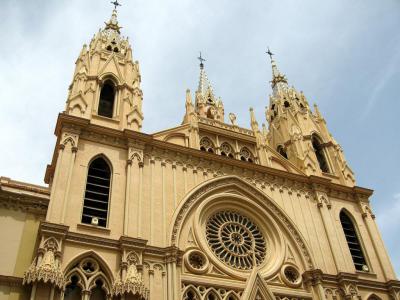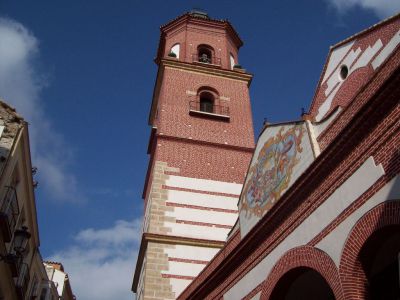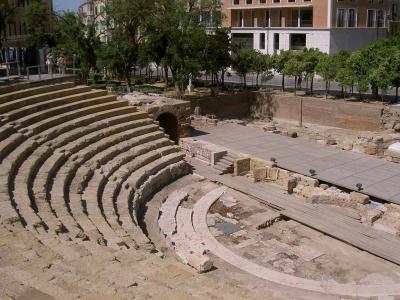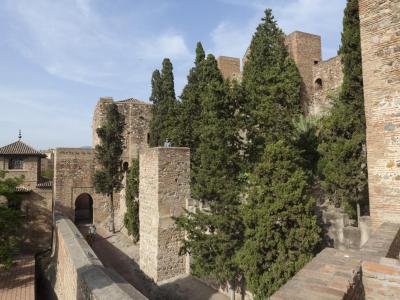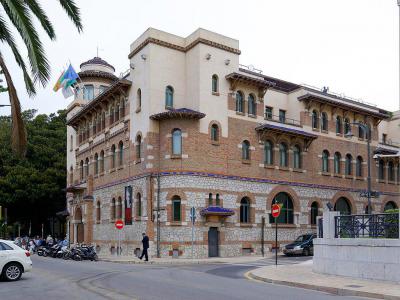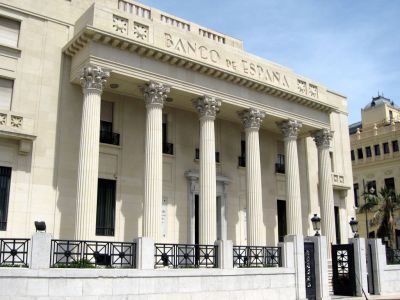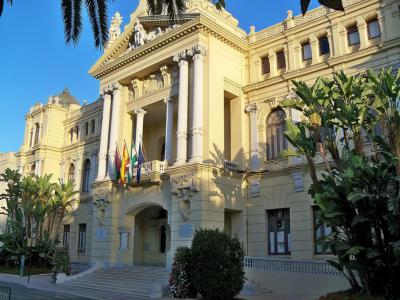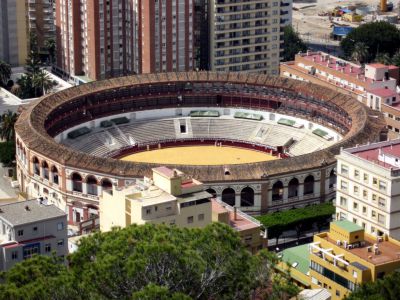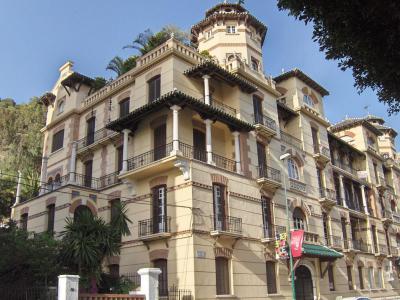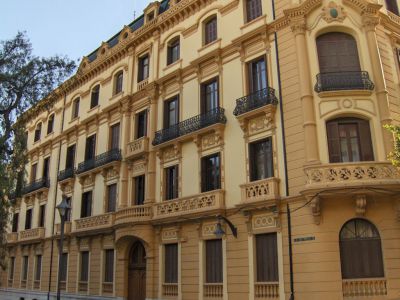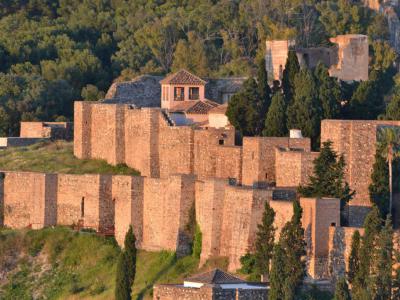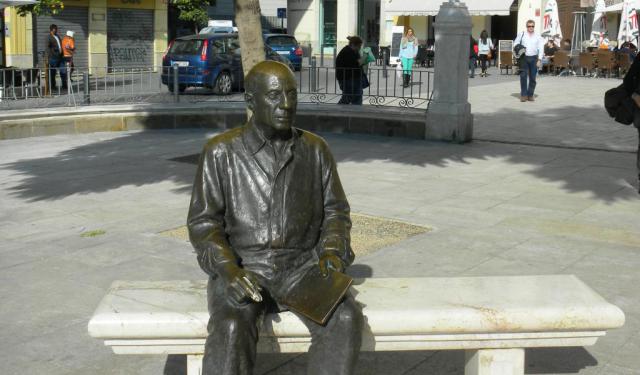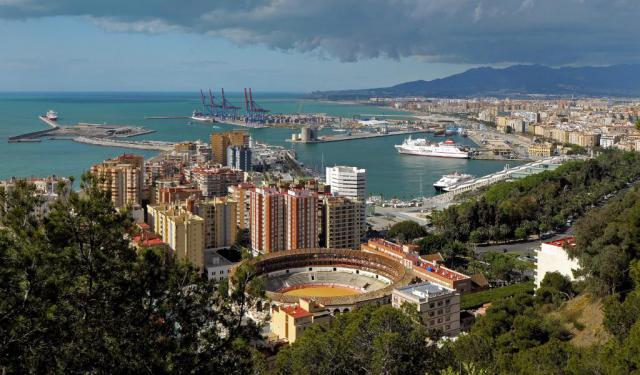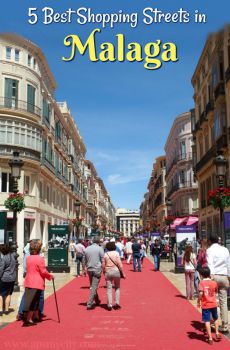Architectural Jewels of Malaga (Self Guided), Malaga
The blooming port city of Málaga has a wealth of architecture with no shortage of ancient and otherwise impressive buildings fit to vow any visitor. Having witnessed the fall and rise of many civilizations, Malaga's uniqueness is marked by the variety of architectural styles, upon which the times past had a great deal of impact. From its stunning Moorish fortress – the best-preserved of its kind in Spain – to its Roman amphitheater, this vibrant and exciting city is full of architectural masterpieces well worth exploring and admiring.
Some of Malaga's finest buildings are centuries old, while others, just as wonderful, have been around for not so long. A good number of emblematic edifices in Malaga date back to the turn of the 20th century and, like the Sacred Heart Church, the City Hall, and Félix Sáenz Houses, were built by the Strachan family.
Among other highlights in the city center worth checking out there are:
Palacio Episcopal de Málaga – a 16th century Episcopal Palace, renowned for its ornate Baroque marble pink, white and grey façade.
Iglesia de San Juan Bautista (Saint John Baptist Church) – successfully combines Gothic and Mujedar styles, with Moorish arches and pillars; completed in 1543.
Iglesia de los Mártires – a Gothic-Mujedar Martyrs' Church; one of the four churches built by the Spanish Catholic Monarchs after the defeat of the Moors in 1487.
Ayuntamiento de Málaga – one of the most beautiful government buildings in Spain; Neo-Baroque styled, completed in 1919.
Palacio de la Tinta (Ink Palace) – a French-influenced edifice; its unique architectural style makes it one of a kind in Malaga.
If you want to know more about the city’s architectural jewels, take this self-guided walking tour. You won’t be disappointed!
Some of Malaga's finest buildings are centuries old, while others, just as wonderful, have been around for not so long. A good number of emblematic edifices in Malaga date back to the turn of the 20th century and, like the Sacred Heart Church, the City Hall, and Félix Sáenz Houses, were built by the Strachan family.
Among other highlights in the city center worth checking out there are:
Palacio Episcopal de Málaga – a 16th century Episcopal Palace, renowned for its ornate Baroque marble pink, white and grey façade.
Iglesia de San Juan Bautista (Saint John Baptist Church) – successfully combines Gothic and Mujedar styles, with Moorish arches and pillars; completed in 1543.
Iglesia de los Mártires – a Gothic-Mujedar Martyrs' Church; one of the four churches built by the Spanish Catholic Monarchs after the defeat of the Moors in 1487.
Ayuntamiento de Málaga – one of the most beautiful government buildings in Spain; Neo-Baroque styled, completed in 1919.
Palacio de la Tinta (Ink Palace) – a French-influenced edifice; its unique architectural style makes it one of a kind in Malaga.
If you want to know more about the city’s architectural jewels, take this self-guided walking tour. You won’t be disappointed!
How it works: Download the app "GPSmyCity: Walks in 1K+ Cities" from Apple App Store or Google Play Store to your mobile phone or tablet. The app turns your mobile device into a personal tour guide and its built-in GPS navigation functions guide you from one tour stop to next. The app works offline, so no data plan is needed when traveling abroad.
Architectural Jewels of Malaga Map
Guide Name: Architectural Jewels of Malaga
Guide Location: Spain » Malaga (See other walking tours in Malaga)
Guide Type: Self-guided Walking Tour (Sightseeing)
# of Attractions: 13
Tour Duration: 2 Hour(s)
Travel Distance: 3.7 Km or 2.3 Miles
Author: HelenF
Sight(s) Featured in This Guide:
Guide Location: Spain » Malaga (See other walking tours in Malaga)
Guide Type: Self-guided Walking Tour (Sightseeing)
# of Attractions: 13
Tour Duration: 2 Hour(s)
Travel Distance: 3.7 Km or 2.3 Miles
Author: HelenF
Sight(s) Featured in This Guide:
- Palacio Episcopal de Málaga (Episcopal Palace)
- Iglesia de San Juan Bautista (Saint John Baptist Church)
- Iglesia del Sagrado Corazón (Sacred Heart Church)
- Iglesia de los Mártires (Martyrs Church)
- Teatro Romano (Roman Theatre)
- Alcazaba of Malaga (Malaga Fortress)
- Rectory of the University of Malaga
- Headquarters of the Bank of Spain in Malaga
- Ayuntamiento de Málaga (Malaga City Hall)
- Plaza de Toros de La Malagueta (La Malagueta Bullring)
- Casas de Félix Sáenz (Félix Sáenz Houses)
- Palacio de la Tinta (Ink Palace)
- Castillo de Gibralfaro (Gibralfaro Castle)
1) Palacio Episcopal de Málaga (Episcopal Palace)
Two palaces make up the Palacio Episcopal de Malaga that stands on the Plaza de Obispo. It is the seat of the Archbishop of Malaga. There are many intricately decorated buildings within the complex making the entire structure a work of art. It is regarded as the finest example of baroque architecture in Andalusia.
The first palace in the complex was built in the 16th century. The second was constructed in the 18th century by Bishop Lasso de Castilla. Architects Antonio Ramos and Jose Martin de Aldehuela designed the building including the ornate Baroque marble façade in colors of pink, white and grey. There is an interior covered patio leading to a grand staircase. On the side, the Bishop’s private patio has 18th century tile work and small tiled fountains. On the third floor is a vaulted ledge that has a beautiful alabaster sculpture of the Virgen de las Angustias by Fernando Ortiz and Manuel Augustin Valero.
The Palacio Episcopal today houses the offices of the Bishop on the top floor. The lower floors are used by the Government of Andalusia for large art exhibitions. The spaces within the building are also used for meetings and other public purposes. There is also a Diocesan Museum of Sacred Art within the complex.
The first palace in the complex was built in the 16th century. The second was constructed in the 18th century by Bishop Lasso de Castilla. Architects Antonio Ramos and Jose Martin de Aldehuela designed the building including the ornate Baroque marble façade in colors of pink, white and grey. There is an interior covered patio leading to a grand staircase. On the side, the Bishop’s private patio has 18th century tile work and small tiled fountains. On the third floor is a vaulted ledge that has a beautiful alabaster sculpture of the Virgen de las Angustias by Fernando Ortiz and Manuel Augustin Valero.
The Palacio Episcopal today houses the offices of the Bishop on the top floor. The lower floors are used by the Government of Andalusia for large art exhibitions. The spaces within the building are also used for meetings and other public purposes. There is also a Diocesan Museum of Sacred Art within the complex.
2) Iglesia de San Juan Bautista (Saint John Baptist Church)
This parish church presides over one of the four parishes established in Malaga after the defeat of the Moors in 1487. Two fraternities that go on procession on Holy Week have chapels within the building. The fraternity of sorrows of San Juan occupies the sacramental chapel and a chapel in the right aisle and the Fused brotherhood occupies four chapels, three in the left aisle and one at the foot of the right aisle.
The church was constructed combining Gothic and Mujedar architectural styles with Moorish arches and pillars. A tower was completed in 1543. The 1680 earthquake damaged the structure including the tower. A baroque style tower porch leading to the building was erected at the entrance of the church in 1770 and reconstruction of the church was completed in 1780. The tower porch has a rectangular shape with an elliptical dome. The chapels and altarpiece of the church are richly carved. There is a splendid 17th-century statue of San Juan by the artist, Franciso Ortiz.
The building has undergone periodic restoration. Extensive repairs were carried out in 1962. Recently, the interiors were given a makeover and the church was repainted from beige to the original white.
Why You Should Visit:
Stands out for its huge tower and very unusual exterior murals from the 18th century.
The interior is a soft shade of blue and also impressive, including the richly decorated altar.
The church was constructed combining Gothic and Mujedar architectural styles with Moorish arches and pillars. A tower was completed in 1543. The 1680 earthquake damaged the structure including the tower. A baroque style tower porch leading to the building was erected at the entrance of the church in 1770 and reconstruction of the church was completed in 1780. The tower porch has a rectangular shape with an elliptical dome. The chapels and altarpiece of the church are richly carved. There is a splendid 17th-century statue of San Juan by the artist, Franciso Ortiz.
The building has undergone periodic restoration. Extensive repairs were carried out in 1962. Recently, the interiors were given a makeover and the church was repainted from beige to the original white.
Why You Should Visit:
Stands out for its huge tower and very unusual exterior murals from the 18th century.
The interior is a soft shade of blue and also impressive, including the richly decorated altar.
3) Iglesia del Sagrado Corazón (Sacred Heart Church)
Located in Plaza de San Ignacio de Loyola, the Church of the Sacred Heart (Iglesia del Sagrado Corazón) is a Neo-Gothic temple, constructed in 1920.
Among the diverse Neo-Gothic churches built in Malaga at the turn of the 20th century, this is the only one located in the Old Town that belongs to the Jesuit Order. Commissioned by the Jesuits, the architect Fernando Guerrero Strachan designed it in January 1907, using the cathedral of Toledo as a model to integrate Islamic elements, as well as the cathedral in Burgos and the monastery of las Huelgas.
The produced result is the basilica, divided into three naves, covered with a ribbed vault. The transept, with an octagonal plan and a star-shaped vault, stands out. The choir is set at the foot of the central nave, which is higher and wider than the side aisles. Another prominent feature is the Gothic-style stained glass windows, produced by Apolo Parkinson Molinari.
Why You Should Visit:
Amid the myriad of impressive churches found in (or around) the historic center of Málaga, this one may appear somewhat tucked away and overshadowed by the Malaga Cathedral, but is still worth checking out, if only for the cleaned stonework – rather pretty, especially when floodlit at night.
Among the diverse Neo-Gothic churches built in Malaga at the turn of the 20th century, this is the only one located in the Old Town that belongs to the Jesuit Order. Commissioned by the Jesuits, the architect Fernando Guerrero Strachan designed it in January 1907, using the cathedral of Toledo as a model to integrate Islamic elements, as well as the cathedral in Burgos and the monastery of las Huelgas.
The produced result is the basilica, divided into three naves, covered with a ribbed vault. The transept, with an octagonal plan and a star-shaped vault, stands out. The choir is set at the foot of the central nave, which is higher and wider than the side aisles. Another prominent feature is the Gothic-style stained glass windows, produced by Apolo Parkinson Molinari.
Why You Should Visit:
Amid the myriad of impressive churches found in (or around) the historic center of Málaga, this one may appear somewhat tucked away and overshadowed by the Malaga Cathedral, but is still worth checking out, if only for the cleaned stonework – rather pretty, especially when floodlit at night.
4) Iglesia de los Mártires (Martyrs Church)
One of the four churches built by the Spanish Catholic Monarchs after the defeat of the Moors in 1487, Iglesia de los Martires is dedicated to two martyred saints, Ciriaco and Paula who were canonized in an early Christian era. The saints, together with Our Lady of Victory are the patron saints of the city of Malaga.
Work on the church began in 1491. Don Diego de Deza increased the pace of building the structure in 1505. The architectural style was Gothic-Mujedar with pointed arches. There are three naves topped with a majestic cupola on top of the main chapel. It underwent extensive renovation in the 18th century and was rededicated in 1777. The church was damaged several times after 1777 and the present structure is a result of repairs and renovations in 1945. The brick church has many styles and the predominant design is Rococo. The tower still retains its Mujedar Moorish design. The church has 11 chapels decorated marble and stone sculpture. In 1545, Diego de Portilla installed a baptismal font. Many of the chapels have gilded altars.
This church of the Martyrs stands on a square called Martyr’s Plaza. A simple church service to honor the martyred saints takes place on 18th June every year.
Why You Should Visit:
The inside is beautifully decorated. The walls and ceiling are white so the artwork shows off quite nicely.
Tip:
Check out the side chapels – in particular, the one containing a life-size naturalistic sculptural depiction of the Last Supper.
Work on the church began in 1491. Don Diego de Deza increased the pace of building the structure in 1505. The architectural style was Gothic-Mujedar with pointed arches. There are three naves topped with a majestic cupola on top of the main chapel. It underwent extensive renovation in the 18th century and was rededicated in 1777. The church was damaged several times after 1777 and the present structure is a result of repairs and renovations in 1945. The brick church has many styles and the predominant design is Rococo. The tower still retains its Mujedar Moorish design. The church has 11 chapels decorated marble and stone sculpture. In 1545, Diego de Portilla installed a baptismal font. Many of the chapels have gilded altars.
This church of the Martyrs stands on a square called Martyr’s Plaza. A simple church service to honor the martyred saints takes place on 18th June every year.
Why You Should Visit:
The inside is beautifully decorated. The walls and ceiling are white so the artwork shows off quite nicely.
Tip:
Check out the side chapels – in particular, the one containing a life-size naturalistic sculptural depiction of the Last Supper.
5) Teatro Romano (Roman Theatre)
The Teatro Romano (or Roman Theater) was discovered while laying the gardens of the Palace archive and Libraries of Malaga. The theater is still in the process of restoration and preservation by archaeologists.
The theater dates back to the 1st century and was constructed during the reign of the Roman Emperor Augustus. At the time, Spain formed the Roman province of Hispania. The theater was used till the 3rd century. The remains were found in 1951 and the building in the location was demolished to facilitate excavation.
The radius of the semicircular space to seat spectators is 31 meters and the theatre is 16 meters high. It is divided by aisles. There is also a 15-meter semicircular space where the orchestra performed. Excavation is still in progress and signs of a larger Roman site are slowly visible. The present theater is a reproduction, although some of the old walls are preserved. The Moors used the stones from the original structure to build the Alcazaba Fortress.
There is a modern interpretation center inaugurated in 2010 where an audio-visual presentation of Roman history and details of the objects found during the excavation are related for the benefit of visitors. The Teatro Romano is located just below the Alcazaba. Visitors can get a full view of the Roman Theater from the top of the fortress.
Tip:
The best views are from the normal public pedestrianized walkways that pass by this the Roman amphitheater.
The theater dates back to the 1st century and was constructed during the reign of the Roman Emperor Augustus. At the time, Spain formed the Roman province of Hispania. The theater was used till the 3rd century. The remains were found in 1951 and the building in the location was demolished to facilitate excavation.
The radius of the semicircular space to seat spectators is 31 meters and the theatre is 16 meters high. It is divided by aisles. There is also a 15-meter semicircular space where the orchestra performed. Excavation is still in progress and signs of a larger Roman site are slowly visible. The present theater is a reproduction, although some of the old walls are preserved. The Moors used the stones from the original structure to build the Alcazaba Fortress.
There is a modern interpretation center inaugurated in 2010 where an audio-visual presentation of Roman history and details of the objects found during the excavation are related for the benefit of visitors. The Teatro Romano is located just below the Alcazaba. Visitors can get a full view of the Roman Theater from the top of the fortress.
Tip:
The best views are from the normal public pedestrianized walkways that pass by this the Roman amphitheater.
6) Alcazaba of Malaga (Malaga Fortress) (must see)
The Malaga Fortress is built on a hill near the center of Malaga. As a military installation, it is ideally situated. It overlooks both the city below and the sea. It is enclosed by two massive walls of stone. It was also attached to the city ramparts and it has strategically located defensive towers.
The outer fortress is accessed by the Vault Gate. The gate was designed to double back on itself, making it difficult for intruders to enter. These days, however, visitors may use the elevator.
A pathway leads up past gardens and ornate fountains through the Gate of Columns or Tower of Christ and then turns abruptly once again with intruders in mind. The inner fortress can be reached by the Gate of the Granada Quarters, which defends the western edge of the palace. The Tower of Tribute takes care of the eastern edge.
Inside this second defensive wall is the palace itself and houses which were built on three patios in the 11th, 13th and 14th centuries. Among them are the Quarters of Granada. The Quarters would serve as residences of governors and as Royal Apartments.
The Malaga Fortress is located at the foot the Gibralfaro hill. It is connected to the Arab defenses by a walled-in passageway called Coracha. The Roman Theatre and the customs building share a space. Here is the opportunity to compare Roman, Renaissance and Arab construction together.
Arab historians claim the palace was built by 1063 by order of King Badis of the Berber Taifa of Granada. Building materials were transported to the site for general construction and the columns while the old Roman theatre supplied materials for capitals and other like uses.
Ferdinand and Isabella seized Malaga in 1487 by one of the longest sieges of the Reconquest. They entered the fortress and raised their royal standard at the Tower of Tribute. That was the day Spain became Spain.
The outer fortress is accessed by the Vault Gate. The gate was designed to double back on itself, making it difficult for intruders to enter. These days, however, visitors may use the elevator.
A pathway leads up past gardens and ornate fountains through the Gate of Columns or Tower of Christ and then turns abruptly once again with intruders in mind. The inner fortress can be reached by the Gate of the Granada Quarters, which defends the western edge of the palace. The Tower of Tribute takes care of the eastern edge.
Inside this second defensive wall is the palace itself and houses which were built on three patios in the 11th, 13th and 14th centuries. Among them are the Quarters of Granada. The Quarters would serve as residences of governors and as Royal Apartments.
The Malaga Fortress is located at the foot the Gibralfaro hill. It is connected to the Arab defenses by a walled-in passageway called Coracha. The Roman Theatre and the customs building share a space. Here is the opportunity to compare Roman, Renaissance and Arab construction together.
Arab historians claim the palace was built by 1063 by order of King Badis of the Berber Taifa of Granada. Building materials were transported to the site for general construction and the columns while the old Roman theatre supplied materials for capitals and other like uses.
Ferdinand and Isabella seized Malaga in 1487 by one of the longest sieges of the Reconquest. They entered the fortress and raised their royal standard at the Tower of Tribute. That was the day Spain became Spain.
7) Rectory of the University of Malaga
The Rectory of the University of Malaga (Rectorado de la Universidad de Málaga) is housed in the Old Post Office building in the city. The style of the structure has Moorish elements that came to be known as Neo Mujedar.
The Cassa de Correos or Post office opened its doors in 1923. It was purpose built based on the plan of architect, Teodoro de Anasagasti y Algan. The building is the finest example of Neo Mujedar architecture in Malaga. The layout of the structure is square with rounded corners and cylindrical towers. The brick and stone façade is enhanced by ornamentation using cobalt blue tiles. To add to the Mujedar atmosphere, cobalt blue tiles are used in the interior especially around windows. An inner patio has a glass ceiling. From the patio visitors can see pits where a fish sauce called Garum was produced. Garum was historically exported to Rome, where it was considered a delicacy.
Until 1986, the building served as the main post office of the city. It then became the office of the Rector of the University of Malaga. The Rectorado de la Universidad de Malaga has a large exhibition hall on the first floor where free exhibitions are held by university scholars.
The Cassa de Correos or Post office opened its doors in 1923. It was purpose built based on the plan of architect, Teodoro de Anasagasti y Algan. The building is the finest example of Neo Mujedar architecture in Malaga. The layout of the structure is square with rounded corners and cylindrical towers. The brick and stone façade is enhanced by ornamentation using cobalt blue tiles. To add to the Mujedar atmosphere, cobalt blue tiles are used in the interior especially around windows. An inner patio has a glass ceiling. From the patio visitors can see pits where a fish sauce called Garum was produced. Garum was historically exported to Rome, where it was considered a delicacy.
Until 1986, the building served as the main post office of the city. It then became the office of the Rector of the University of Malaga. The Rectorado de la Universidad de Malaga has a large exhibition hall on the first floor where free exhibitions are held by university scholars.
8) Headquarters of the Bank of Spain in Malaga
Found between the City Hall and the Old Post Office House, on Paseo del Parque, the Headquarters of the Bank of Spain in Malaga (Sede del Banco de Espana en Malaga) is a neoclassical building designed by architect Jose Yarnoz Larrosa. It was built from 1933 to 1936.
In keeping with the solid image of the bank headquarters that it represents, the three-storey building's shape and elements are meant to produce a strong impression. To this end, the architect used an imposing façade with its main element being a hexastyle porch with Corinthian columns supporting a portico. This columned portico, presiding over the front facing the park, represents a key link with historicist architecture, but with the fascist architectural aesthetics quite common during the 1930s, and as such is the highlight of the building.
With this, the edifice successfully reflects the idea of a great public property, both ancient and contemporary at the same time.
In keeping with the solid image of the bank headquarters that it represents, the three-storey building's shape and elements are meant to produce a strong impression. To this end, the architect used an imposing façade with its main element being a hexastyle porch with Corinthian columns supporting a portico. This columned portico, presiding over the front facing the park, represents a key link with historicist architecture, but with the fascist architectural aesthetics quite common during the 1930s, and as such is the highlight of the building.
With this, the edifice successfully reflects the idea of a great public property, both ancient and contemporary at the same time.
9) Ayuntamiento de Málaga (Malaga City Hall)
This baroque style structure is one of the most beautiful government buildings in Spain. The façade and interiors have many beautifully preserved works of art by well known local artists. It is located in an elegantly landscaped garden near the Alcazaba fortress.
Two local architects, Fernando Guerrero Strachan and Manuel Rivera Vera, designed the Ayuntamiento de Málaga. Intended for housing the offices of the local government, this Neo-Baroque structure was completed in 1919. The building has three floors and a clock tower. The façade is covered with sculptures of men, garlands of fruits and vegetables created by artist Diego Garcia Carreras. The interior is full of artistic and architectural treasures including the sculpture of a woman who represents the city surrounded by figures representing architecture, commerce, fishing and the sea.
The first floor has stained glass windows that represent the history of Malaga. The second floor has the offices of the mayor, the council meeting room and the famous Hall of Mirrors with Neo-Rococo designed mirror frames and a ceiling with paintings by well-known artists. The Hall of Mirrors is the best-known part of the building. The corridors of the second floor have portraits of all the 20th-century Mayors of Málaga painted by prominent artists.
Visitors require special permission enter the building to view its magnificent interior art and architecture.
Two local architects, Fernando Guerrero Strachan and Manuel Rivera Vera, designed the Ayuntamiento de Málaga. Intended for housing the offices of the local government, this Neo-Baroque structure was completed in 1919. The building has three floors and a clock tower. The façade is covered with sculptures of men, garlands of fruits and vegetables created by artist Diego Garcia Carreras. The interior is full of artistic and architectural treasures including the sculpture of a woman who represents the city surrounded by figures representing architecture, commerce, fishing and the sea.
The first floor has stained glass windows that represent the history of Malaga. The second floor has the offices of the mayor, the council meeting room and the famous Hall of Mirrors with Neo-Rococo designed mirror frames and a ceiling with paintings by well-known artists. The Hall of Mirrors is the best-known part of the building. The corridors of the second floor have portraits of all the 20th-century Mayors of Málaga painted by prominent artists.
Visitors require special permission enter the building to view its magnificent interior art and architecture.
10) Plaza de Toros de La Malagueta (La Malagueta Bullring)
La Malagueta, the bullring of Malaga, can be found in the center of the city, near the Paseo de Reding. The structure of the arena is in the style of neomudejar in the shape of a hexadecagon (16 sides). The ring measures 169 feet in diameter. It has holding pens, stables, dressing rooms, and most importantly, a first aid post.
La Malagueta hosts events during the fighting season, including two fights in Holy Week. One of the fights is named Corrida Picassiana for Pablo Picasso. When Picasso was a child, his father often brought him here to watch bullfights. It was here Picasso developed a lifelong passion for bullfighting.
The contest between man and bull appears often in Picasso's sketches and paintings. In a 1925 painting of his son Paul, the child was dressed in the traditional costume of a bullfighter with the red cape in one hand. In the background, one can see the subtle outline of a bullring arena.
The bullring has a season from April to September. It is a short walk from Malagueta beach in the eastern part of the old town. The best view of the ring is from the Castle of Gibralfaro, above the Malaga Fortress.
La Malagueta hosts events during the fighting season, including two fights in Holy Week. One of the fights is named Corrida Picassiana for Pablo Picasso. When Picasso was a child, his father often brought him here to watch bullfights. It was here Picasso developed a lifelong passion for bullfighting.
The contest between man and bull appears often in Picasso's sketches and paintings. In a 1925 painting of his son Paul, the child was dressed in the traditional costume of a bullfighter with the red cape in one hand. In the background, one can see the subtle outline of a bullring arena.
The bullring has a season from April to September. It is a short walk from Malagueta beach in the eastern part of the old town. The best view of the ring is from the Castle of Gibralfaro, above the Malaga Fortress.
11) Casas de Félix Sáenz (Félix Sáenz Houses)
Behind the Bullring of Malagueta, on Paseo de Reding, on the left side, there are two notable buildings, called Casas de Felix Saenz. These blocks of flats are named in memory of Felix Saenz, a major homeowner, who commissioned their construction in 1922. Intended for rental, these properties still serve in this capacity today.
The houses were designed by the architect Fernando Guerrero Strachan, and consist of three floors, plus basement and attic towers. The facades are articulated in recesses and projections, causing flown pavilions, terraces, balconies and glazing windows of different heights. This provides a wealth of color, accentuated in the early hours of morning and the afternoon.
The overall style is the so-called “Regionalist” of the Malaga-Este District, with the external decoration comprising Neo-Mudejar and Neo-Renaissance elements, characteristic of the 1920s. The obscure Regionalism can be characterized as post-modern and has retained the elegance of the "Belle Époque" architectural forms, although stricter and without curved lines. Instead, multi-capacity, niches and balconies with tiled awnings are widely used. These elements, quite typical of Andalusian individual homes, are the hallmark of local Regionalism.
The houses were designed by the architect Fernando Guerrero Strachan, and consist of three floors, plus basement and attic towers. The facades are articulated in recesses and projections, causing flown pavilions, terraces, balconies and glazing windows of different heights. This provides a wealth of color, accentuated in the early hours of morning and the afternoon.
The overall style is the so-called “Regionalist” of the Malaga-Este District, with the external decoration comprising Neo-Mudejar and Neo-Renaissance elements, characteristic of the 1920s. The obscure Regionalism can be characterized as post-modern and has retained the elegance of the "Belle Époque" architectural forms, although stricter and without curved lines. Instead, multi-capacity, niches and balconies with tiled awnings are widely used. These elements, quite typical of Andalusian individual homes, are the hallmark of local Regionalism.
12) Palacio de la Tinta (Ink Palace)
The old Palacio de la Tinta (Ink Palace) is a French-influenced edifice, located on Paseo de Reding, next to the Edificio de viviendas "Desfile del Amor" residential building, which is in the La Malagueta neighborhood of the Centro district.
The 10.500 square meters palace was constructed in 1908 in the Parisian style - fin de siecle, and was designed by architect Julio O'Brien, who also equipped it with three courtyards, stables and elevator floors.
The building stands on a plinth of stone and has three facades: the main one overlooking Paseo de Reding in front of the Felix Saenz houses. The architect used classical elements, such as the Corinthian columns, the standing out stipes or struts, to create a historicism close to modernism, which is very unique in Malaga. The heritage value of this property is also enriched by other elements, such as the steeply sloping slate roof or the French-influenced dormers.
Originally, the building housed the headquarters of the Andalusian Railway Company, but now is the seat of the Andalusian Water Agency. The property owes its name to the former tenant, under whose occupancy the large quantities of ink had to be moved around the building daily in order to issue railway tickets by hand.
The 10.500 square meters palace was constructed in 1908 in the Parisian style - fin de siecle, and was designed by architect Julio O'Brien, who also equipped it with three courtyards, stables and elevator floors.
The building stands on a plinth of stone and has three facades: the main one overlooking Paseo de Reding in front of the Felix Saenz houses. The architect used classical elements, such as the Corinthian columns, the standing out stipes or struts, to create a historicism close to modernism, which is very unique in Malaga. The heritage value of this property is also enriched by other elements, such as the steeply sloping slate roof or the French-influenced dormers.
Originally, the building housed the headquarters of the Andalusian Railway Company, but now is the seat of the Andalusian Water Agency. The property owes its name to the former tenant, under whose occupancy the large quantities of ink had to be moved around the building daily in order to issue railway tickets by hand.
13) Castillo de Gibralfaro (Gibralfaro Castle) (must see)
This castle is an ancient fortress resting on top of the Gibralfaro Hill. The peak is 131 meters high and offers spectacular views of the city of Malaga and the Mediterranean Sea. The image of the structure is depicted on the seal and flag of Malaga City.
The Moors erected the fortress near an old lighthouse constructed by the Phoenicians. The name Gibralfaro comes from 'gabel' which means rock in Arabic and 'faro' meaning lighthouse in Greek. Abd-al-Rahman III, the Caliph of Cordoba commissioned the construction of a castle at the site. Yusef I, the Sultan of Grenada, built additional structures including a walled passage that connects the castle with the Alcazaba, in the 14th century.
The Christian monarchs, Ferdinand and Isabella, laid siege to the castle for three months. The siege ended only when hunger forced the Moorish armies to surrender. This was the first time that both armies used gunpowder. After victory, Ferdinand stayed at the castle while Isabella remained in the city.
Today visitors can reach the castle by bus, taxi or by climbing the steps to the summit. They can only see the ruins of the castle and the mosque that once stood at the location. There are several bread ovens and wells within the property. The old gunpowder room now houses an information center and there is a small one-room museum with exhibits that tell the once glorious tale of the castle.
Why You Should Visit:
Excellent attraction not just for history buffs but for anyone wanting to get the best views of this beautiful city and the sea.
Another advantage of starting any historic endeavor at this castle is that you are then able to work your way down the hill (public footpath) to the next phase of historic attractions.
Tip:
The site is perhaps best experienced by walking around the walls which can sometimes be high and often unprotected, as well as narrow – so do be patient and do take care. Taking young children onto the walls is not a very good idea, or if you do, make sure to permanently hold on to them... and tightly.
The Moors erected the fortress near an old lighthouse constructed by the Phoenicians. The name Gibralfaro comes from 'gabel' which means rock in Arabic and 'faro' meaning lighthouse in Greek. Abd-al-Rahman III, the Caliph of Cordoba commissioned the construction of a castle at the site. Yusef I, the Sultan of Grenada, built additional structures including a walled passage that connects the castle with the Alcazaba, in the 14th century.
The Christian monarchs, Ferdinand and Isabella, laid siege to the castle for three months. The siege ended only when hunger forced the Moorish armies to surrender. This was the first time that both armies used gunpowder. After victory, Ferdinand stayed at the castle while Isabella remained in the city.
Today visitors can reach the castle by bus, taxi or by climbing the steps to the summit. They can only see the ruins of the castle and the mosque that once stood at the location. There are several bread ovens and wells within the property. The old gunpowder room now houses an information center and there is a small one-room museum with exhibits that tell the once glorious tale of the castle.
Why You Should Visit:
Excellent attraction not just for history buffs but for anyone wanting to get the best views of this beautiful city and the sea.
Another advantage of starting any historic endeavor at this castle is that you are then able to work your way down the hill (public footpath) to the next phase of historic attractions.
Tip:
The site is perhaps best experienced by walking around the walls which can sometimes be high and often unprotected, as well as narrow – so do be patient and do take care. Taking young children onto the walls is not a very good idea, or if you do, make sure to permanently hold on to them... and tightly.
Walking Tours in Malaga, Spain
Create Your Own Walk in Malaga
Creating your own self-guided walk in Malaga is easy and fun. Choose the city attractions that you want to see and a walk route map will be created just for you. You can even set your hotel as the start point of the walk.
Pablo Picasso's Malaga
Among other things for which Malaga has gone down in history is being the town where Pablo Picasso, the famous painter and innovator of the Cubist movement, was born and spent his early childhood. The milieu and the daily life of those years inspired some of Picasso’s most characteristic subjects in paintings, such as flamenco, doves and bulls.
The best place to start a walk through... view more
Tour Duration: 1 Hour(s)
Travel Distance: 1.3 Km or 0.8 Miles
The best place to start a walk through... view more
Tour Duration: 1 Hour(s)
Travel Distance: 1.3 Km or 0.8 Miles
Malaga Introduction Walking Tour
Malaga is old. It is 2,800 years old. It is thought to have been founded by Phoenician traders in 770 BC. From its beginnings, it was a natural waypoint between Phoenicia in the eastern Mediterranean and Gibraltar. Cathaginians and, later, Romans ruled the city. Their core settlements were in an area between Gibralfaro Hill to the Guadalmedina River.
From the eighth century to the end of the... view more
Tour Duration: 2 Hour(s)
Travel Distance: 3.4 Km or 2.1 Miles
From the eighth century to the end of the... view more
Tour Duration: 2 Hour(s)
Travel Distance: 3.4 Km or 2.1 Miles
Useful Travel Guides for Planning Your Trip
5 Best Shopping Streets in Malaga, Spain
As well as one of the best cultural destinations in southern Spain, Malaga turns out to be something of a shopping mecca. Along with the ubiquitous shopping malls on the outskirts, the capital of Costa del Sol has managed to preserve its network of specialist shops, difficult to find in most big...
The Most Popular Cities
/ view all



